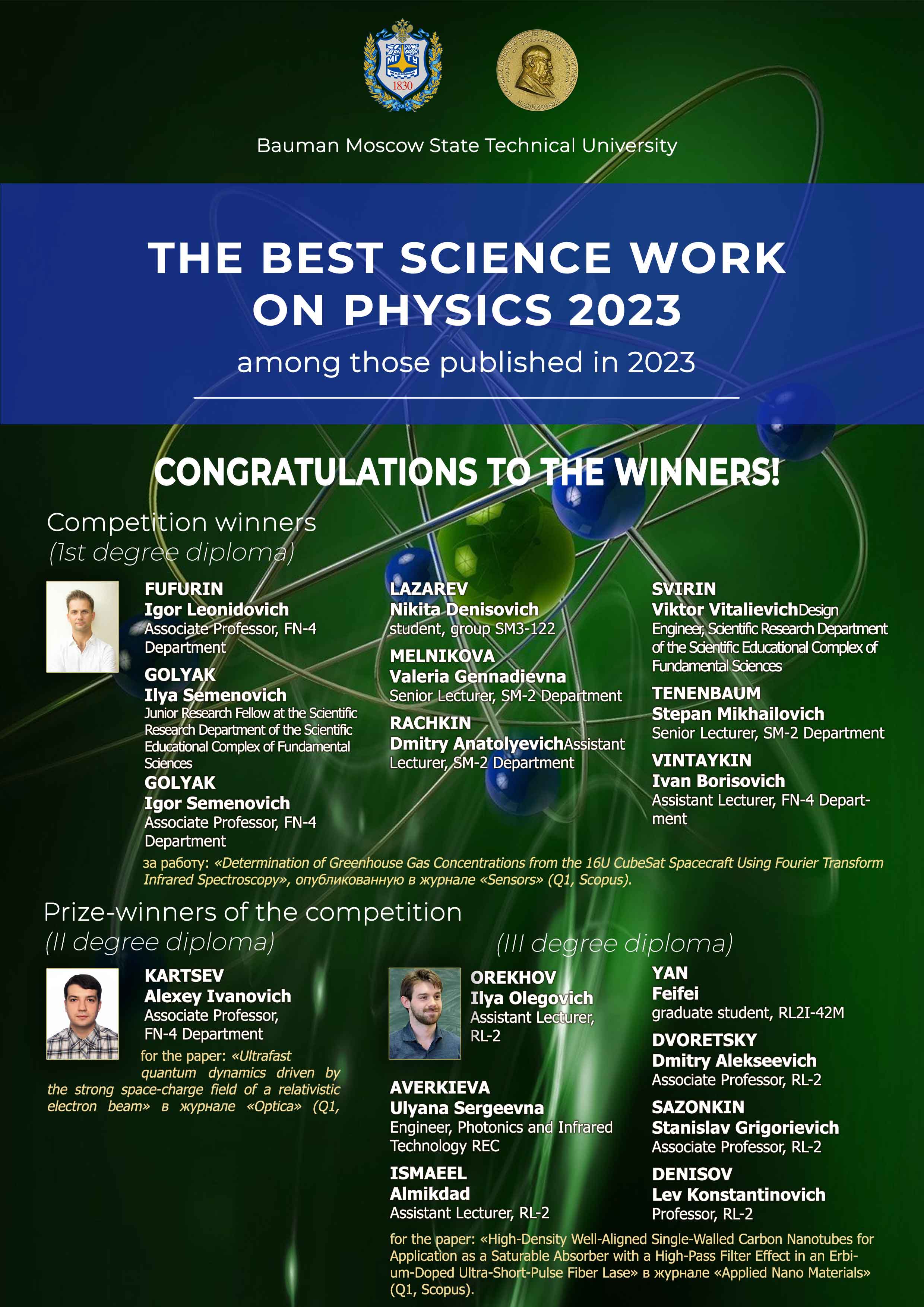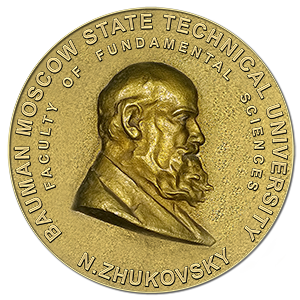
In order to encourage research in physics, the Bauman Moscow State Technical University held its annual competition for the best papers in physics among those published in 2023.
After much deliberation, the winners and top rankings for the papers in physics were determined as follows:
1st place for the best scientific publication in physics in 2023:
Fufurin Igor Leonidovich, Associate Professor, FN-4 Department
Golyak Ilya Semenovich, Junior Research Fellow at the Scientific Research Department of the Scientific Educational Complex of Fundamental Sciences
Golyak Igor Semenovich, Associate Professor, FN-4 Department
Lazarev Nikita Denisovich, student, group SМ3-122
Melnikova Valeria Gennadievna, Senior Lecturer, SM-2 Department
Rachkin Dmitry Anatolyevich, Assistant Lecturer, SM-2 Department
Svirin Viktor Vitalievich, Design Engineer, Scientific Research Department of the Scientific Educational Complex of Fundamental Sciences
Tenenbaum Stepan Mikhailovich, Senior Lecturer, SM-2 Department
Vintaykin Ivan Borisovich, Assistant Lecturer, FN-4 Department
for the paper "Determination of Greenhouse Gas Concentrations from the 16U CubeSat Spacecraft Using Fourier Transform Infrared Spectroscopy", published in "Sensors" (Q1, Scopus).
The paper describes the design as well as principles of operation and control for small spacecraft (SSC) of the CubeSat U16 type, designed to solve remote sensing problems, such as measuring greenhouse gas concentrations remotely from a near-Earth heliocentric orbit and estimating their dynamics.
The paper states a method for converting the absorption line measurements for the greenhouse gases analyzed to the O2 absorption line, making it possible to evaluate integral concentrations in the atmospheric column. S wath scanning potential is considered, taking into account the stabilization of the SSC along three axes. The paper also presents the results of long-term ground measurements demonstrating how the method performs in terms of determining greenhouse gas concentrations and their dynamics.
A distinctive feature of the study is the fact that it was authored by a joint team of authors representing both FN and SM faculties, contributing to the development of inter-faculty scientific collaboration.
The remaining top rankings in the 2023 competition for the best scientific publication in physics include:
2nd place
Kartsev Alexey Ivanovich, Associate Professor, FN-4 Department
for the paper "Ultrafast quantum dynamics driven by the strong space-charge field of a relativistic electron beam" in "Optica" (Q1, Scopus).
The major finding of the study may be the validation of a technique consisting of using a Coulomb field pulse, compressed to attosecond durations and synchronized with an X-ray pulse in a controlled manner.
The novelty of the technique is as follows. In an ultrafast pump-probe experiment, an electron beam is first formed so that it has two short spikes: the second ("tail") spike is used to generate X-rays, and the first ("head") spike is used as a Coulomb field pulse. A magnetic spacetime manipulator is used to adjust the delay time of the Coulomb field electronic pulse relative to the X-ray pulse. In this case, the Coulomb field is completely compressed, and the X-ray pulse is strongly chirped.
The paper shows that, in comparison with a conventional laser, the relativistic Coulomb field boasts unique properties that enable novel studies of ultrafast and strong-field dynamics. It can be compressed to attosecond pulse lengths and focused to atomic field strengths. The X-ray pulse duration may also be compressed to attosecond lengths.
The combination of short pulses and a high repetition rate allows the space-charge field to test material property limits and improve understanding of energy transfer at ultrafast time scales. The techniques proposed may also be used to study ultrafast reactions in photochemistry, to study the optoelectronic properties of various materials, and to control large-amplitude motion of atomic nuclei. The ability not only to generate excited states, but also to control them and then probe them with soft X-rays unveils new modes of attosecond physics made possible by modern free-electron lasers.
A distinctive feature of the study is its international team of co-authors. The paper was co-authored by D. Cesar, A. Acharya, J.P. Cryan, M.F. Kling, a.m. Lindenberg, C.D. Pemmaraju, A.D. Poletayev, V.S. Yakovlev, A. Marinelli from the National Accelerator Laboratory, Menlo Park, USA, Stanford PULSE Institute, SLAC National Accelerator Laboratory, Menlo Park, USA, Department of Applied Physics, Stanford University, USA, Department of Materials Science and Engineering, Stanford University, USA, Stanford Institute for Materials and Energy Sciences, SLAC National Accelerator Laboratory, Menlo Park, USA, Theory Institute for Materials and Energy Spectroscopies, SLAC National Accelerator Laboratory 94025, Menlo Park, USA, Department of Materials, University of Oxford, Oxford OX13RQ, UK, Max Planck Institute of Quantum Optics, Germany, Department of Physics, Ludwig-Maximilians-Universität Munich, Germany.
3rd place
Orekhov Ilya Olegovich, Assistant Lecturer, RL-2
Averkieva Ulyana Sergeevna, Engineer, Photonics and Infrared Technology REC
Ismaeel Almikdad, Assistant Lecturer, RL-2
Yan Feifei, graduate student, RL2I-42M
Dvoretsky Dmitry Alekseevich, Associate Professor, RL-2
Sazonkin Stanislav Grigorievich, Associate Professor, RL-2
Denisov Lev Konstantinovich, Professor, RL-2
for the paper "High-Density Well-Aligned Single-Walled Carbon Nanotubes for Application as a Saturable Absorber with a High-Pass Filter Effect in an Erbium-Doped Ultra-Short-Pulse Fiber Lase" in "Applied Nano Materials" (Q1, Scopus).
The findings presented in the paper are of considerable interest and importance from a practical point of view. The key finding of the study is an experimental demonstration of the possibility of reducing output power noise and instability of pulse repetition rate for an erbium fiber laser featuring a hybrid mode-locking mechanism by means of a filter effect enabled by unique high-density carbon nanotubes, which are used as an additional saturable absorber and frequency filter in the laser circuit. It is worth noting that reducing the output power noise and the pulse repetition rate (which may be conveyed together as increasing the stability of ultrashort laser pulse generation) is a fundamental yet rather difficult step on the way to creating a stabilized optical comb, which should find application in science, medicine and industry. However, in addition to active stabilization of laser parameters, it is equally important to be able to stabilize them passively, which can significantly improve the parameters of the entire system and make it cheaper. It is this method of increasing the stability of laser pulse generation that has been successfully demonstrated in the investigation. Important theoretical results have been obtained, which may also be used in practice when creating stabilized ultra short pulse laser systems.
Congratulations to the winners!


